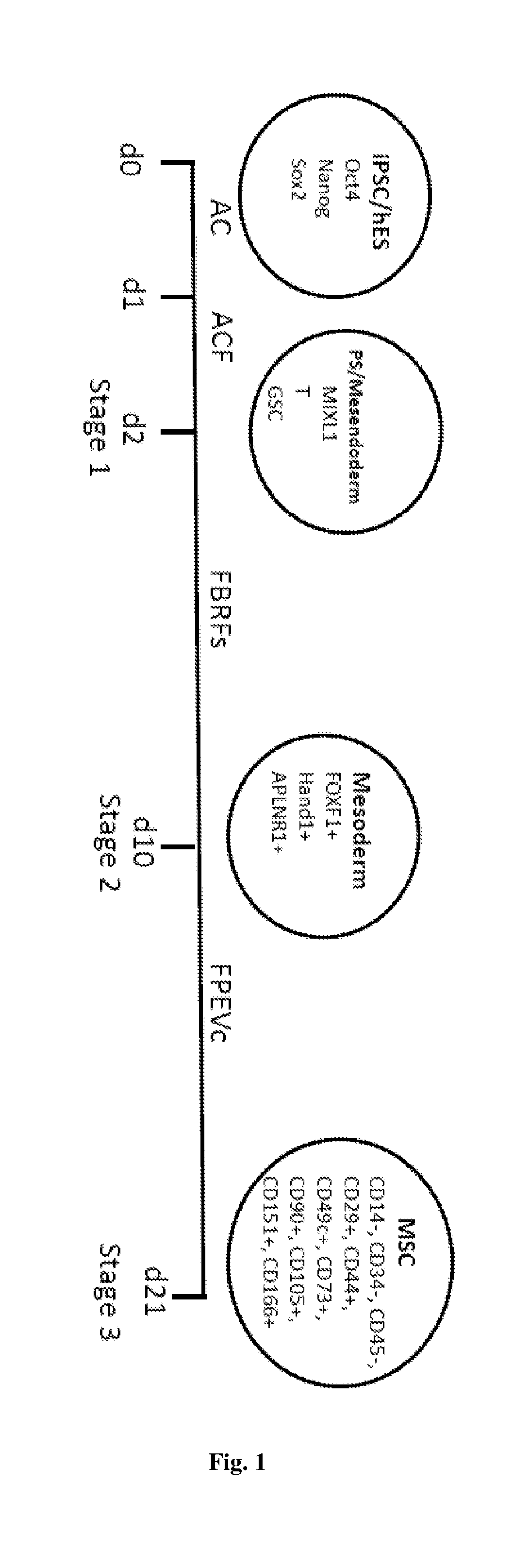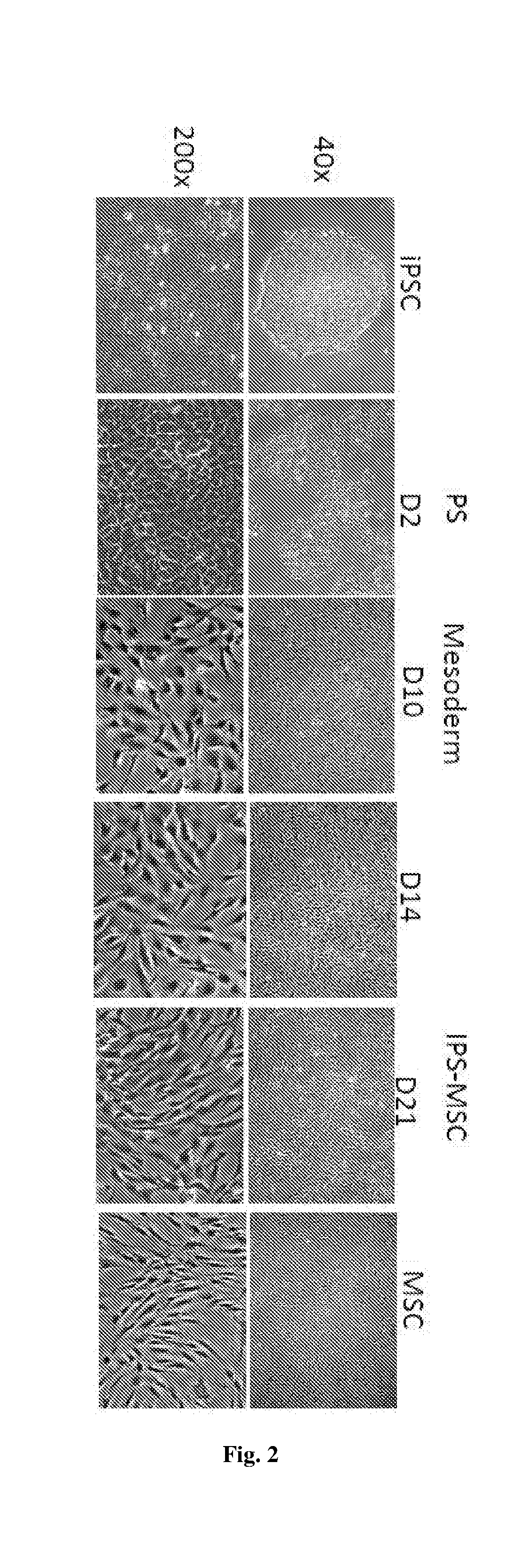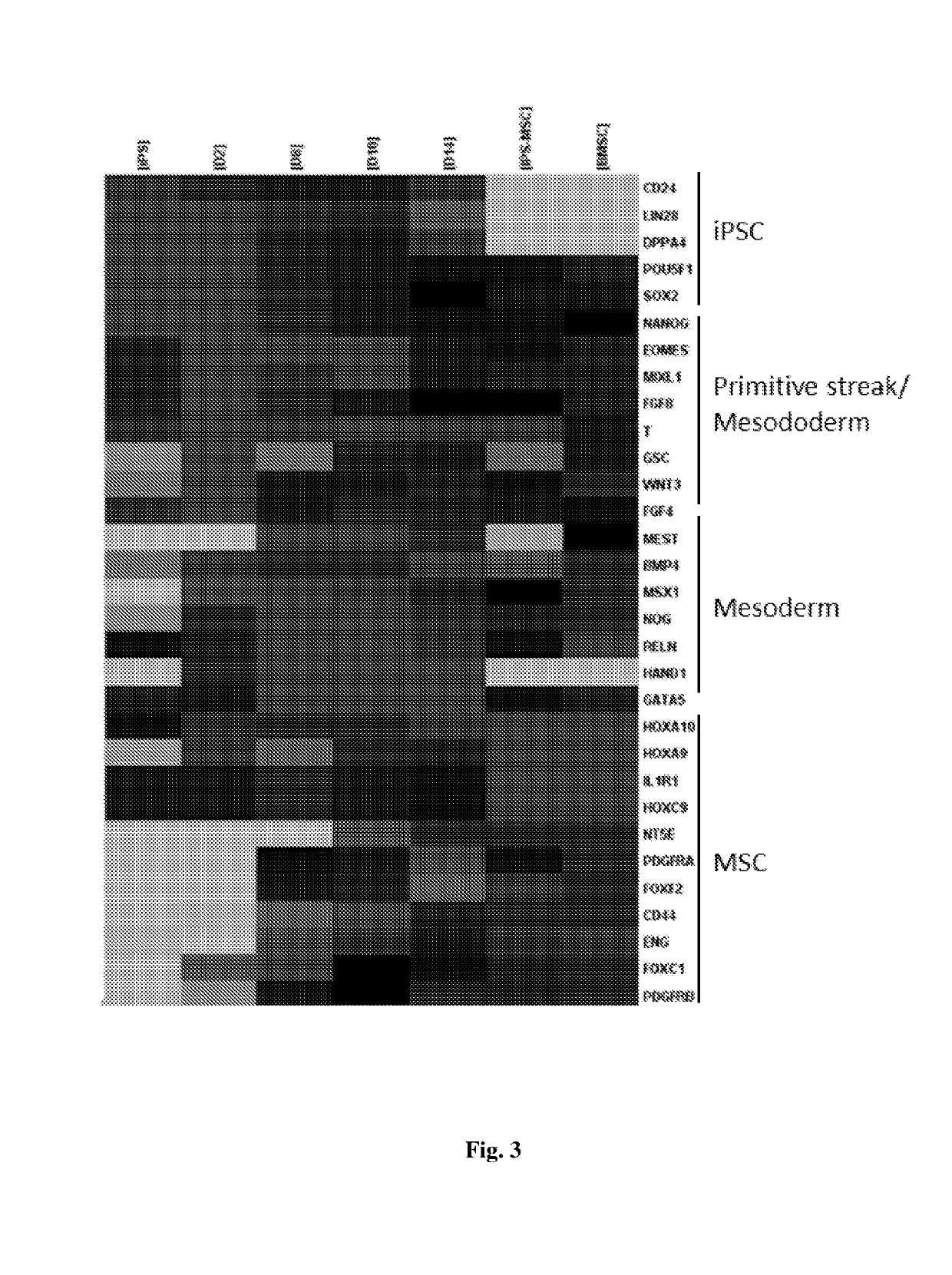Method of generating mesenchymal stem cells and uses thereof
a mesenchymal stem cell and stem cell technology, applied in the field of cell biology and biochemistry, can solve the problems of poor joint pain, inflammation, etc., and achieve the effect of improving the intrinsic healing capacity of articular cartilag
- Summary
- Abstract
- Description
- Claims
- Application Information
AI Technical Summary
Benefits of technology
Problems solved by technology
Method used
Image
Examples
examples 1
of Induced Pluripotent Stem Cells
[0193]Human induced pluripotent stem cells (iPSCs) were generated by infecting fibroblasts of MRCS or BJ cells with four retroviruses encoding human Oct4, Sox2, KLF4 and c-Myc. GP2 cells were transfected with four factors and virus was harvested forty-eight hour post-transduction. Fibroblasts were infected with harvested virus. Five days after infection, infected MRCS cells were plated onto mouse embryonic fibroblast feeder cells treated with mitomycin C and cultured in human ES medium to generate iPSCs.
[0194]The iPSC colonies displayed typical ES-like morphology on the feeder (FIG. 16A) or feeder-free culture (FIG. 16B). Similar to hES cells, the colonies of iPSCs were AP positive (FIG. 16C), which were different from fibroblasts negative for AP stain. Immunostaining showed that iPSCs were positive for hES markers including Oct4, Nanog, Sox2, SSEA4, Tra-1-80 and Lin28 by immunocytochemistry staining (FIG. 9D). The generated iPSCs formed teratomas co...
example 2
iation of Human Embryonic Stem Cells (hESC) or iPSCs and into Primitive Streak or Primitive Streak-Like Mesendoderm Cells
[0195]iPSCs from MRCS or BJ cell lines, or hESCs were differentiated into primitive streak-like mesendoderm cells and primitive streak mesendoderm cells respectively. Feeder-free iPSCs were maintained in mTeSR (Stem Cell Technologies) before differentiation. To differentiate iPSCs, iPSCs were digested with 1 mg / ml collagenase IV for 5-10 min at 37° C. into small clumps and placed on a fibronectin (FN, 10 μg / ml)-coated surface in medium containing activin A (25 ng / ml) and CHIR99021 (3 μM) for 1 day in a basal medium (DMEM: F12, 1% ITS, 2% B27, 2 mM L-Glutamine, 90 uM ß-mercaptoethanol), followed by Activin A (25 ng / ml), CHIR99021 (3 μM) and FGF (20 ng / ml) for subsequent 24 hours to differentiate toward primitive streak (PS)-like mesendoderm.
[0196]To ensure high efficiency of iPSCs toward PS or PS-like mesendoderm, low confluent iPSCs (around 20%) with small clumps ...
example 3
iation of Primitive Streak or Primitive Streak-Like Mesendoderm Cells Towards Mesoderm Cells
[0198]Mesoderm differentiation was induced with FGF (20 ng / ml), BMP4 (40 ng / ml), rock inhibitor Y27632 (5 μM, only used at the time of passage and remove the next day) and follistatin (100 ng / ml) for 8 days.
[0199]To determine concentrations of BMP4 for mesodermal differentiation, the present data showed that 40 ng / ml BMP4 led to the highest expression of lateral plate mesoderm markers. On the contrary, ectodermal gene Sox1 was also highly expressed in the absence of BMP4 or in the presence of noggin (38.65-fold) (FIG. 10A). The present data showed that follistatin inhibited endodermal differentiation Sox17 and FOXA1, while promoting mesodermal differentiation (FIG. 10B). To promote cell survival and reduce cell death, FGF and a ROCK inhibitor Y27632 were used. Compared with cytokine neurotrophi-4 (NT), ROCK inhibitor Y27632 increased cell number by 3.53±1.56 fold at day 10. At the same time, ...
PUM
| Property | Measurement | Unit |
|---|---|---|
| concentration | aaaaa | aaaaa |
| concentration | aaaaa | aaaaa |
| concentration | aaaaa | aaaaa |
Abstract
Description
Claims
Application Information
 Login to View More
Login to View More - R&D
- Intellectual Property
- Life Sciences
- Materials
- Tech Scout
- Unparalleled Data Quality
- Higher Quality Content
- 60% Fewer Hallucinations
Browse by: Latest US Patents, China's latest patents, Technical Efficacy Thesaurus, Application Domain, Technology Topic, Popular Technical Reports.
© 2025 PatSnap. All rights reserved.Legal|Privacy policy|Modern Slavery Act Transparency Statement|Sitemap|About US| Contact US: help@patsnap.com



